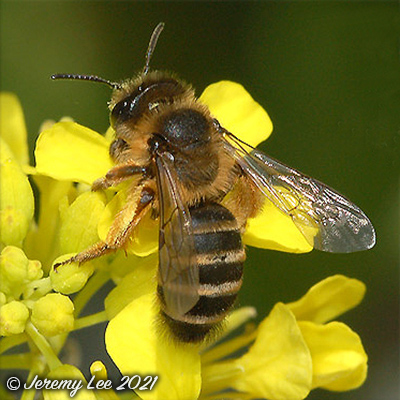
 |
|
Scientific Classifications explained » Amphibians » Ants » Aphids » Bees » Beetles » Birds » Bugs » Butterflies » Caterpillars » Damselflies » Dragonflies » Earwigs » Flies » Frog/Leafhoppers » Fungi » Galls » Grasshoppers » Harvestmen » Hoverflies » Lacewings » Ladybirds » Leaf Mines » Lichens » Mammals » Millipedes » Mosses » Moths » Sawflies » Slugs » Snails » Spiders » Trees & Shrubs » Wasps » Wild Flowers » Woodlice » Postboxes |
UK Nature > Bees > Andrena flavipes

Scientific Name: Mining Bee Scientific Name: Andrena flavipes Andrena flavipes is a very common mining bee in the UK. Not only is it very common in England and parts of Wales, it also regularly appears in great numbers. The white bands between the tergites are striking. Males and females are quite similar, except for the hairs, especially on the head. These are whitish grey in males and reddish brown in females. The males are also slimmer and lack the dense brush of orange-yellow hairs on the hind leg (shown on the female in the photo above). The nests of Andrena flavipes are constructed in the ground, and are often found in dense aggregations in suitable,exposed banks and cliffs, tended lawns, flower beds, roadside verges and in sparsely vegetated field margins. It is not a specialized feeder: any flower may be be visited and checked for the presence of nectar. A.flavipes has two broods per year; the spring generation, seen mainly in April and May, is usually bigger than the summer generation, flying about in July and August. It is spreading northwards nowadays, both in Britain and Europe, and was recently recorded in Sweden. |
|

https://www.uknature.co.uk is a website dedicated to showing the immense diversity of UK nature and wildlife. Our vast range of habitats, from lowland arable to snow covered mountains, from storm-ravaged coastlines to peaceful inland freshwater lakes and rivers, from dry, sandy heaths to deciduous and coniferous forests, all these habitats contribute to the abundance of UK nature. We have wild birds in huge numbers either residing or visiting our shores (597 recorded species as at July 2013) and we must also not forget the humble back garden with its grass lawns, flower beds filled with nectar rich flowers, shrubs and trees, all designed to attract huge numbers of insects such as bees, moths, butterflies and hoverflies; and finally the small ponds which provide safe havens for frogs, toads, newts and even slow worms and grass snakes. www.uknature.co.uk is the showcase for my personal passion, photographing uknature in all its glory. I sincerely hope you all enjoy the fruits of my labours. This site and all images contained therein is © Jeremy Lee 2004 - 2025. All Rights Reserved. Site design by Jeremy Lee. Site development & IT Support by Stuart Lee. |